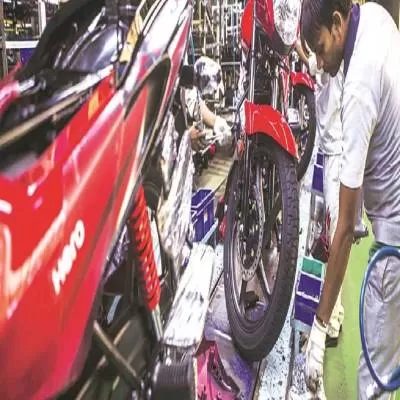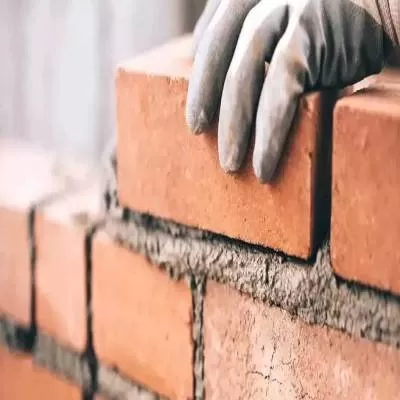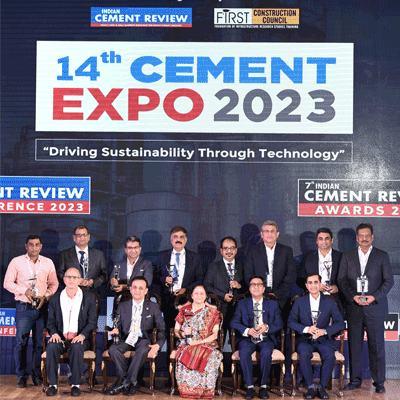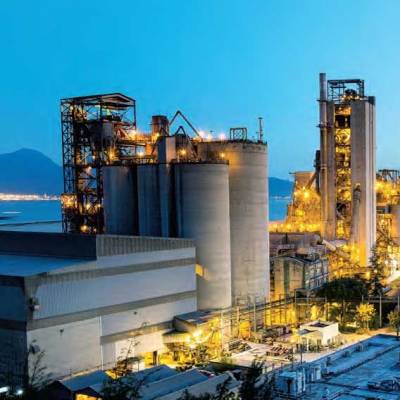- Home
- Building Material
- Cement
- What Lies Beneath

What Lies Beneath
Coir geotextile mats, shredded waste plastic, nano-coated hydrophilic fibres, industrial slag, fly-ash, and marble slurry dust are some new materials finding a place in road construction.
Riding on coir
In Kerala, the Public Works Department is testing the use of coir geotextiles in road construction on a 3-km stretch on the Ambalappuzha-Thiruvalla road.
Coir geotextile mats improve the properties and strength of the subgrade material, typically soil, thus reducing the thickness of the required aggregate layer and translating into cheaper roads, even after taking into consideration the cost of geotextiles - roughly Rs 50 to Rs 65 per sq m in manufacturing units in and around Alleppy and Kochi.
´Based on the California Bearing Ratio, using 900 gsm mats with laterite soil would reduce the granular sub-base quantity by about 27 per cent and the binder coarse quantity by 16 per cent, cutting the cost by about 23 per cent,´ says Dr KS Beena, Professor of Civil Engineering, School of Engineering, Cochin University of Science and Technology, who was involved in field trials using coir geotextiles.
By preventing the aggregate from mixing with the soil, and thereby averting the loss of the effective thickness of the aggregate layer, coir geotextile mats also improve the performance of the road and cut maintenance costs. ´Laboratory strength tests of the wheel track, the California Bearing Ratio test and the bearing capacity show that coir geotextile mats strengthen the pavement and result in fewer rut formations,´adds Dr Beena. ´While coir geotextile mats are useful for both rural roads and highways, more field trials have been done for rural roads and introducing relevant standards for the use of the material and approving it in governmental schedules will help boost adoption.´
Self-repairing roads
Cost-effective, sustainable, long-lasting self-repairing roads are a long-felt need, dependent on combined research in materials science and structural engineering, according to Dr Satish Chandra, Director, CSIR-Central Road Research Institute (CRRI).´Of late, we have heard of the development of this distinct technology, with researchers formulating stabilised road structures.
If the technology withstands tests, it will have immense potential for India.´ India´s ostensibly first self-repairing road is a 650-m stretch connecting village Thondebavi in southeast Karnataka´s district Chikkaballapura to the nearest highway that has self-crack healing properties from being composed of nano-coated, hydrophilic (water attracting) fibres in additional to conventional materials. ´A crack always has unhydrated cement, that is, cement that has not reacted with water yet, and has the ability to form chemical products that can heal the crack,´says Dr Nemkumar Banthia, developer of the fibres, and CEO & Scientific Director, Canada India Research Centre of Excellence (IC-IMPACTS) at The University of British Columbia.´By keeping the cracks narrow using fibre reinforcement and then by attracting water via hydrophilic fibres, further bond-enhancing silicates can be created that, in time, close - or heal - the crack. The key is to keeping cracks narrow and then provide mechanisms that repair the crack.´ Another standout feature is that the road - built in 2015 as a sample and successfully tested through the 2016 monsoon - is high strength, and is made of 60 per cent less cement than a conventional road. Instead it uses fly-ash for a final road thickness of 100 mm instead of the typical 250 mm.´Despite using an imported ingredient - the nano-coated hydrophilic fibres - the road cost 30 per cent less to make than a conventional road for being thinner and, therefore, needing less material,´says Dr Banthia, who expects the road to last about 15 years despite being thinner.
Highways can also be built using the self-healing technology and the reduction in thickness is expected to be nearly 50 per cent. The exact savings in cost will depend on the soil conditions, traffic volume and environmental conditions. While the nano-coated, hydrophilic fibre is currently being developed at the University of British Columbia, Dr Banthia sees plenty of scope to make the material locally, if it is widely adopted.´Make in India is a good initiative to make this possible,´he adds.
Recycle those plastic bags
It is pertinent to use waste plastic in the construction of roads to reduce its accumulation across India, says Dr Chandra. Plastic, a toxic material, constitutes almost 5 per cent of municipal solid waste. Plastic waste is an eyesore and causes the choking of drains, hygiene problems and land toxicity. Guidelines for the use of waste plastic in bituminous road construction are well developed with the IRC publishing document IRC:SP 98-2013, an outcome of a concerted effort of CRRI and other researchers, he adds.
´Modifying the bituminous mix with shredded waste plastic increases the mix cost by about Rs 3,000 per tonne,´points out Dr Chandra.´However, this marginal increase in cost is compensated by increase in the volume of the total mix, thereby resulting in less overall bitumen content, better performance and environmental conservation.´ Patent A- CH/871 registered in 2002 corresponds to a method of using plastic in road construction. Accordingly, for example, 1 tonne of shredded waste plastic and 9 tonne of bitumen are used for laying 1 km of a 3.75-m-wide road, says the patent holder Dr Rajagopalan Vasudevan, Dean ECA and Professor, Department of Chemistry, Thiagarajar College of Engineering.
A wide variety of plastic-like films (from carry bags, cups) of thickness up to 60 micron, hard foam of any thickness, soft foam of any thickness, laminated plastic of thickness up to 60 micron (aluminium coated will also do) and plastic wrappers used for confectionery products can be used after shredding. PVC sheets or flex sheets should be excluded.
The waste plastic is shredded such that it can pass through a 4.7-mm sieve and be retained in a sieve of size 1.36 mm. The aggregate is heated to 170oC and the shredded waste plastic is sprayed over the aggregate. The waste plastic gets melted at the surface of the aggregate and gets coated. To this mixture, one adds a calculated quantity of hot bitumen.
According to Dr Vasudevan,´Aggregate coated with molten plastic binds better with bitumen, and hence leads to stronger roads. Also, coating stones with molten plastic prolongs their life and fills surface voids, thereby significantly reducing their capacity to absorb moisture.´
Over 20,000 km of rural roads in Tamil Nadu alone have been constructed using plastic wastes while not less than 50,000 km of roads have been laid using this technology.
´Using shredded waste plastic in road construction cuts costs by approximately Rs 50,000 per km of road laid,´adds Dr Vasudevan. Reusing flexible pavement scrap by coating it with waste plastic can further cut the cost to half that of a conventional road by reducing the raw material consumption by roughly 50 per cent. Doing so also maintains the level of the road.
QUICK BYTES
- Coir geotextile mats better roads performance and cut maintenance costs.
- By using self-healing technology in highways, the reduction in thickness is nearly 50 per cent.
- A wide variety of plastic-like films can be used after shredding in the construction of roads.
- Skid resistance, texture and bump integrator studies show that plastic roads offer acceptable skid resistance, texture and unevenness index values respectively, and are reasonably strong.
More new materials and methods in road construction
Warm and cold bituminous mixes reduce road production temperatures from about 160oC to 110oC, and thus become environment-friendly for cutting fuel costs, fumes and emissions and the ageing of the binder, opines Dr Satish Chandra, Director, CSIR-Central Road Research Institute.´Cool weather paving becomes possible.
Besides, the time window for paving gets extended as the warm and cold mixes contain additives and emulsions respectively. This is especially useful in hilly regions.´
Recycling old, distressed bituminous pavements ensures the reuse of scrap and ushers in savings in stone aggregates, a fast depleting natural resource. A twist to the conventional reuse of the recovered aggregates in new bituminous layers is to use the scrap in non-bituminous granular layers.´Whereas the former method makes use of part of the scrap, the latter method uses it fully,´says Dr Chandra.
- Charu Bahri
To share your insights on Road Construction Technologies, write in at feedback@ConstructionWorld.in
- Coir geotextile mats
- Nano-coated hydrophilic fibres
- Dr KS Beena
- Cochin University of Science and Technology
- California Bearing Ratio
- CSIR-Central Road Research Institute
- Dr Satish Chandra
- Dr Nemkumar Banthia
- Fibre reinforcement
- Make in India
- Dr Rajagopalan Vasudevan
- Dean ECA
- Aluminium coated
- Road construction
- Dr Satish Chandra
- Charu Bahri
New materials in road construction bode well for surface longevity, cost control and environment conservation. Coir geotextile mats, shredded waste plastic, nano-coated hydrophilic fibres, industrial slag, fly-ash, and marble slurry dust are some new materials finding a place in road construction. Riding on coir In Kerala, the Public Works Department is testing the use of coir geotextiles in road construction on a 3-km stretch on the Ambalappuzha-Thiruvalla road. Coir geotextile mats improve the properties and strength of the subgrade material, typically soil, thus reducing the thickness of the required aggregate layer and translating into cheaper roads, even after taking into consideration the cost of geotextiles - roughly Rs 50 to Rs 65 per sq m in manufacturing units in and around Alleppy and Kochi. ´Based on the California Bearing Ratio, using 900 gsm mats with laterite soil would reduce the granular sub-base quantity by about 27 per cent and the binder coarse quantity by 16 per cent, cutting the cost by about 23 per cent,´ says Dr KS Beena, Professor of Civil Engineering, School of Engineering, Cochin University of Science and Technology, who was involved in field trials using coir geotextiles. By preventing the aggregate from mixing with the soil, and thereby averting the loss of the effective thickness of the aggregate layer, coir geotextile mats also improve the performance of the road and cut maintenance costs. ´Laboratory strength tests of the wheel track, the California Bearing Ratio test and the bearing capacity show that coir geotextile mats strengthen the pavement and result in fewer rut formations,´adds Dr Beena. ´While coir geotextile mats are useful for both rural roads and highways, more field trials have been done for rural roads and introducing relevant standards for the use of the material and approving it in governmental schedules will help boost adoption.´ Self-repairing roads Cost-effective, sustainable, long-lasting self-repairing roads are a long-felt need, dependent on combined research in materials science and structural engineering, according to Dr Satish Chandra, Director, CSIR-Central Road Research Institute (CRRI).´Of late, we have heard of the development of this distinct technology, with researchers formulating stabilised road structures. If the technology withstands tests, it will have immense potential for India.´ India´s ostensibly first self-repairing road is a 650-m stretch connecting village Thondebavi in southeast Karnataka´s district Chikkaballapura to the nearest highway that has self-crack healing properties from being composed of nano-coated, hydrophilic (water attracting) fibres in additional to conventional materials. ´A crack always has unhydrated cement, that is, cement that has not reacted with water yet, and has the ability to form chemical products that can heal the crack,´says Dr Nemkumar Banthia, developer of the fibres, and CEO & Scientific Director, Canada India Research Centre of Excellence (IC-IMPACTS) at The University of British Columbia.´By keeping the cracks narrow using fibre reinforcement and then by attracting water via hydrophilic fibres, further bond-enhancing silicates can be created that, in time, close - or heal - the crack. The key is to keeping cracks narrow and then provide mechanisms that repair the crack.´ Another standout feature is that the road - built in 2015 as a sample and successfully tested through the 2016 monsoon - is high strength, and is made of 60 per cent less cement than a conventional road. Instead it uses fly-ash for a final road thickness of 100 mm instead of the typical 250 mm.´Despite using an imported ingredient - the nano-coated hydrophilic fibres - the road cost 30 per cent less to make than a conventional road for being thinner and, therefore, needing less material,´says Dr Banthia, who expects the road to last about 15 years despite being thinner. Highways can also be built using the self-healing technology and the reduction in thickness is expected to be nearly 50 per cent. The exact savings in cost will depend on the soil conditions, traffic volume and environmental conditions. While the nano-coated, hydrophilic fibre is currently being developed at the University of British Columbia, Dr Banthia sees plenty of scope to make the material locally, if it is widely adopted.´Make in India is a good initiative to make this possible,´he adds. Recycle those plastic bags It is pertinent to use waste plastic in the construction of roads to reduce its accumulation across India, says Dr Chandra. Plastic, a toxic material, constitutes almost 5 per cent of municipal solid waste. Plastic waste is an eyesore and causes the choking of drains, hygiene problems and land toxicity. Guidelines for the use of waste plastic in bituminous road construction are well developed with the IRC publishing document IRC:SP 98-2013, an outcome of a concerted effort of CRRI and other researchers, he adds. ´Modifying the bituminous mix with shredded waste plastic increases the mix cost by about Rs 3,000 per tonne,´points out Dr Chandra.´However, this marginal increase in cost is compensated by increase in the volume of the total mix, thereby resulting in less overall bitumen content, better performance and environmental conservation.´ Patent A- CH/871 registered in 2002 corresponds to a method of using plastic in road construction. Accordingly, for example, 1 tonne of shredded waste plastic and 9 tonne of bitumen are used for laying 1 km of a 3.75-m-wide road, says the patent holder Dr Rajagopalan Vasudevan, Dean ECA and Professor, Department of Chemistry, Thiagarajar College of Engineering. A wide variety of plastic-like films (from carry bags, cups) of thickness up to 60 micron, hard foam of any thickness, soft foam of any thickness, laminated plastic of thickness up to 60 micron (aluminium coated will also do) and plastic wrappers used for confectionery products can be used after shredding. PVC sheets or flex sheets should be excluded. The waste plastic is shredded such that it can pass through a 4.7-mm sieve and be retained in a sieve of size 1.36 mm. The aggregate is heated to 170oC and the shredded waste plastic is sprayed over the aggregate. The waste plastic gets melted at the surface of the aggregate and gets coated. To this mixture, one adds a calculated quantity of hot bitumen. According to Dr Vasudevan,´Aggregate coated with molten plastic binds better with bitumen, and hence leads to stronger roads. Also, coating stones with molten plastic prolongs their life and fills surface voids, thereby significantly reducing their capacity to absorb moisture.´ Over 20,000 km of rural roads in Tamil Nadu alone have been constructed using plastic wastes while not less than 50,000 km of roads have been laid using this technology. ´Using shredded waste plastic in road construction cuts costs by approximately Rs 50,000 per km of road laid,´adds Dr Vasudevan. Reusing flexible pavement scrap by coating it with waste plastic can further cut the cost to half that of a conventional road by reducing the raw material consumption by roughly 50 per cent. Doing so also maintains the level of the road. QUICK BYTES Coir geotextile mats better roads performance and cut maintenance costs. By using self-healing technology in highways, the reduction in thickness is nearly 50 per cent. A wide variety of plastic-like films can be used after shredding in the construction of roads. Skid resistance, texture and bump integrator studies show that plastic roads offer acceptable skid resistance, texture and unevenness index values respectively, and are reasonably strong. More new materials and methods in road construction Warm and cold bituminous mixes reduce road production temperatures from about 160oC to 110oC, and thus become environment-friendly for cutting fuel costs, fumes and emissions and the ageing of the binder, opines Dr Satish Chandra, Director, CSIR-Central Road Research Institute.´Cool weather paving becomes possible. Besides, the time window for paving gets extended as the warm and cold mixes contain additives and emulsions respectively. This is especially useful in hilly regions.´ Recycling old, distressed bituminous pavements ensures the reuse of scrap and ushers in savings in stone aggregates, a fast depleting natural resource. A twist to the conventional reuse of the recovered aggregates in new bituminous layers is to use the scrap in non-bituminous granular layers.´Whereas the former method makes use of part of the scrap, the latter method uses it fully,´says Dr Chandra. - Charu Bahri To share your insights on Road Construction Technologies, write in at feedback@ConstructionWorld.in



















